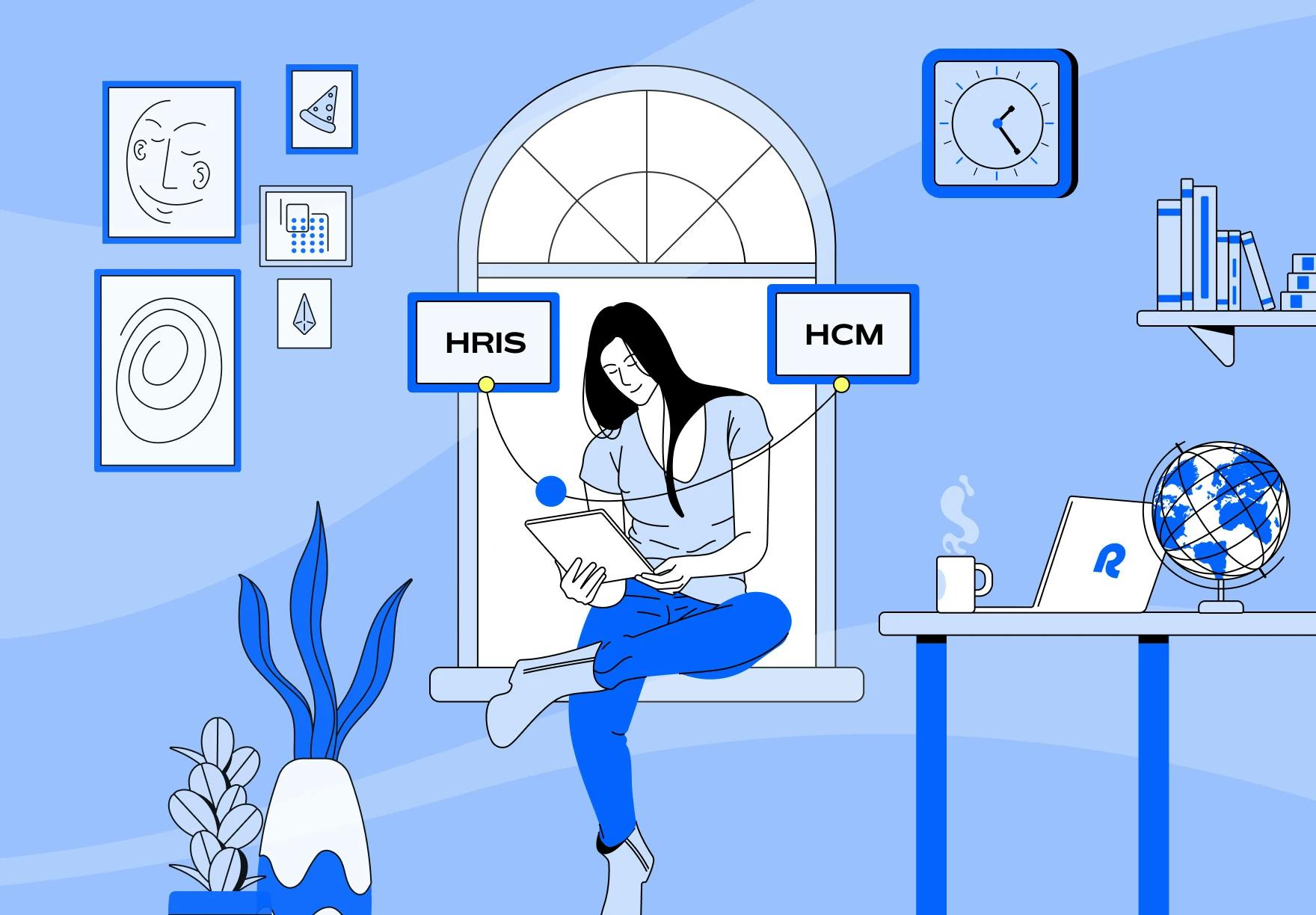
Remote & Async Work — 14 min

Human resources professionals need to consider numerous factors to secure top talent, satisfy team members, and increase productivity. If your organization operates internationally, your HR needs are even more complex.
Your current HR software may not be an ideal solution to strategize your HR plans. If you factor in your organization's future goals, it may be time for a new HR system.
But do you need a human resource information system (HRIS) or human capital management (HCM) software? Which one will help you to hire globally without adding an extra headache to your HR workflow?
Knowing the core differences between HRIS and HCM is essential when planning your business’s next move. This guide covers the similarities and differences between HRIS and HCM systems. It also presents an overview of which businesses stand to benefit from each.
Cloud-based HRIS and HCM software solutions help HR professionals consolidate data and manage payroll, benefits, and employee development more effectively. While the terms are often used interchangeably, each of these solutions solves a different set of problems and has a distinct set of advantages.
The main difference between HRIS and HCM has to do with their complexity. An HCM system encompasses much of the same functionality as an HRIS but generates more in-depth data points on employee and enterprise performance.
Overall, HRIS systems are best for managing HR functions, while HCM solutions are most helpful for enterprise planning and growth strategy.
When choosing HR software, it’s crucial to not only understand your current requirements but also have an idea of what you might need five or ten years down the line.
Let's take a closer look at the differences between HRIS and HCM softwares.
HRIS systems streamline core HR processes, including recruitment, time management, benefits, and training. An HRIS includes several user permission levels, which means you can give employees self-service access (to edit personal data, enter time-off requests, or view payroll receipts) and offer higher access levels to HR personnel.
Companies spend an average of 15 weeks determining the right HR software system — with 25% looking to HRIS as a way to add functionality to their HR processes. HRIS systems improve overall efficiency by syncing multiple HR processes into a single cloud-based platform. In addition, these systems ensure accurate employee data (for example, between payroll and timesheet entries) through built-in data validation features.
Certain HRIS systems allow companies to more easily standardize company-wide policies, and others support third-party integrations to import cloud-based data. Still other HRIS providers include functions for compliance monitoring and custom reports, though these are more limited in scope than they are for other types of HR software.
While the exact functionality might vary between providers, an HRIS system generally includes the following core HR functions:
Employee information: An HRIS system is designed to house all employee information in a single platform. This includes personal details, time tracking, benefits, payroll information, and benefits. Cloud-based HRIS software uses enterprise-grade cybersecurity to protect employee data from external threats while also scanning for data inconsistencies between employee data in different HR fields.
Recruiting: Some HRIS systems allow users to create job postings, track recruitment sources, conduct background checks, and scan resumes. While choosing the right candidate for the job is ultimately up to a human, HRIS softwares handle administrative work to help HR professionals focus on discovering top global talent.
Time tracking: Time and attendance tracking are vital components of an HRIS system that help employees and managers accurately record (and validate) standard and overtime work hours for payroll processing. HRIS systems designed for hybrid teams also allow managers and employees to set in-office or at-home hours during the work week.
Benefits and compensation management: An HRIS lets employees track and manage their own benefits packages (including retirement and healthcare plans) while allowing HR managers to see how those benefits are actually being used. More advanced HRIS systems help benchmark standard benefits packages within a certain region or industry.
Employee portal: A cloud-based HRIS can boost employee satisfaction by allowing employees to view and manage their own time-off requests, payroll, and benefits through a self-service employee portal. Meanwhile, HR professionals can focus on other high-value job activities.
Virtually any company can benefit from implementing an HRIS system, though these systems come at a cost that is more easily justifiable at scale. For this reason, HRIS systems are best suited for small-to-medium enterprises, large companies, or smaller organizations in high-profit industries.
Companies with a distributed or growing workforce could also benefit from an HRIS, as it simplifies payroll and helps bolster recruiting efforts. Employee self-service features are particularly useful for companies with distributed or hybrid teams, as HR professionals could become easily overwhelmed using in-house solutions to track hours, payroll, and benefits.
Keep in mind that a global HRIS system offers additional benefits for companies going global. International businesses may require a global HR partner like Remote to take care of onboarding, payroll, benefits, and compliance for their international teams.
Think of an HCM system as an HRIS plus. HCMs cover the same core HR functions as HRIS systems (onboarding, absence management, benefits, and training), and also provide insight into performance management.
While an HRIS is most useful for saving time, improving accuracy, and enabling employee self-service, an HCM tracks metrics to predict long-term organizational success.
An HCM’s features include workflow automation for labor-intensive tasks, such as performance reviews, timesheet approvals, payroll management, and talent optimization.
An HCM measures more than employee output — a well-calibrated system can even help assess a team member's professional strengths, aspirations, and level of engagement in their current role.
HCMs come in many shapes and sizes. While some HCM softwares are more suited to certain industries than others, most HCMs offer the following:
HRIS functionality: An HCM encompasses the same core functionality as an HRIS while adding a deeper level of analysis. There can be specific UI or UX features for certain HCM platforms.
Talent acquisition: HCM systems can identify an organization's internal and external talent requirements for the present and the future. HCM systems significantly cut down time to hire team members and discover hard-to-find talent.
Talent management and optimization: HCM softwares help HR professionals manage and optimize their workforce, to make sure each individual is engaged and well-placed within an organization. HR managers meet their company's objectives employee training and strategic personnel placements.
In sum, an HCM builds on HRIS functionality by offering HR professionals data-based insights into how to best utilize their workforce. Many HCMs are standalone products, while other providers offer HRIS and HCM functionality at different subscription levels.
An HCM carries a higher price tag than an HRIS. It also has a greater potential for return on investment (ROI) at scale. In fact, the global HCM market value is expected to nearly double between 2023 and 2030 from $28.86 billion to $53.16 billion. This demonstrates the substantial value these systems deliver to organizations.
An HCM system is most suitable for large organizations with a talent-based service or offering. It is meant for companies that are looking to identify skill gaps, develop talent more efficiently, and find opportunities for workforce management that can impact their bottom line.
If your business needs a way to better manage core HR functions, an HRIS will likely be sufficient. If you need more in-depth functionality to understand how talent management can align your team members with company strategies, an HCM is a better option.
Selecting the right HRIS or HCM depends on multiple factors. This includes your current HR bottlenecks, your medium to long-term goals, and whether you use a global versus local approach to recruitment.
Manage essential HR functions across a distributed workforce
Include an employee interface
Help attract and retain talent
Have database management and benefits functions
HCM builds on HRIS systems; HCM provides more functions than HRIS
HCM specializes on people strategy within an organization
HCM offers deeper insights to align employee talent with an organization's long-term strategy
A human resources management system (HRMS) is another type of HR software that builds on HRIS. Fifty percent of large businesses report using a licensed HRMS to manage their core HR functions. However, HRMS solutions may not offer the same level of enterprise planning as an HCM.
An HRMS is similar to an HRIS, though it includes more in-depth payroll (including payment processing) as well as time and labor management (TLM). HRMS solutions make it easier for HR professionals to attract and retain talent through simplified onboarding, performance monitoring, and employee engagement.
HRMS software is geared toward mid-sized businesses with complex onboarding, training needs, and benefits packages.
For more details on HRIS, HCM, and HRMS, take a look at our detailed guide on HRIS for companies going global.
Choosing the right software package can be challenging, given the sheer number of providers in the market. The HR software industry has grown about 10% per year in the US between 2018 and 2023.
If your business currently hires globally, you could require specialized technology that supports a global-first approach. Remote’s global HR platform goes beyond HRIS and HCM by ensuring compliance with local standards at every point in the people management process, from onboarding to payroll and benefits.
Don't forget to factor in your organization's future requirements when choosing an HR software. Here are a few aspects to consider when choosing a HR partner that satisfies your unique needs:
For some organizations, HR systems might need a degree of customization and can come with a learning curve. Choosing a provider that can help tailor the system to your specific needs will ensure the greatest ROI with the shortest possible implementation time.
HR softwares should be able to connect seamlessly with your current cloud-based information systems, pulling data like as employee information and company policies into the application. Third-party applications allow for enhanced capabilities in accounting, time management, payroll, and recruitment. For example, Remote’s API allow HR managers access employee and payroll information across platforms.
Artificial intelligence can help with automated workflows, advanced recruitment through tailored candidate searches, continuous learning, and business insights into employee performance and engagement. 92% of HR leaders plan to integrate AI into their core HR areas, including performance management, payroll, and benefits.
HR softwares streamline the complex tasks of hiring, managing, and retaining top talent in today’s market. The latest HR management software simplifies core HR processes to save time, improve accuracy, and ultimately improve the employee experience.
Both HRIS and HCM systems store employee information, facilitate onboarding, and simplify HR workflows and compensation management. HCM systems go a step further than HRIS by adding advanced analytics to better understand talent gaps and skill allocation within a company.
Companies that are operating internationally may require more than an HRIS or HCM. Hiring and retaining global talent requires best practices that ensure compliance in any country around the world.
Remote’s global HR platform helps companies onboard, manage, and pay international hires compliantly with ease.
Book a demo to start building your global team with Remote.
Subscribe to receive the latest
Remote blog posts and updates in your inbox.